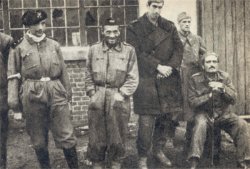
POW from Mokotow
Warsaw Uprising insurgents in German POW camps
The beginning of the Warsaw Uprising on August 1st, 1944 resulted in violent reaction of the leaders of the III Reich. The policy that was in place since the beginning of the WWII in 1939 of discrimination and extermination had been further escalated.
After the first victories of insurgents, on Hitler's personal orders to fight Polish fighters an additional force was added including Storm Brigadoon of 1700 troops of Russian collaborators under the command of SS officer Mieczyslaw Kaminski.
In accordance with Hitler's directives, received during the first days of August 1944, Himmler issued the following orders:
1. Captured insurgents shall be killed irrespective of the Hague Convention rules of combat
2. Civilians, including women and children, shall be killed
3. The city was to be razed to the ground including buildings, streets, infrastracture and chattels.
Every inhabitant shall be killed, no prisoners were to be taken. Warsaw was to be razed to the ground and give the whole Europe a terrifying example.”
The orders were put in motion with a full force. In each and every district taken by the German SS and Wehrmacht soldiers committed hidious crimes. In Wola, Ochota and Mokotow insurgents taken into captivity were shot on a spot, as were the wounded in the hospitals.
Near Pecice, a group of insurgents retreating from Ochota was taken into captivity. The next day all insurgents were killed by a special SS commando that arrived from Pruszkow.
Similar event took place in Mokotow. After an attack on a Racetrack had failed,all wounded laying on the ground were killed. In addition, peasants living nearby and forced to collect the wounded were murdered as well.
In Wola and Ochota upon withdrawal of the insurgents a crime against civilans had been committed. Several tenths of thousands of civilians, including women and children, were murdered.
On August 5th, 1944 SS- Obergruppenfuhrer Erich von dem Bach Zelewski came to Warsaw. He decided to change the tactic, to shoot only men participating in a combat and direct all civilians to a transition camp Dulag 121 in Pruszkow. Germans started a leaflet campaign urging insurgents and civilians to surrender.
Later, Himmler issued an order to von dem Bach, directing him to send combatants to the concentration camps and the rest, including women and children, to labour camps in Germany. Those unsuitable for work - (elderly, sick etc.) were to be relocated throughout the General Guberny.
Directive was relayed to the commendants of concentration camps in Auschwitz, Buchenwald, Dachau, Floosenburg, Hinzart, Bergen- Belsen, Neuengamme, Natzwerler, Ravensbruck, Mauthausen, Gross-Rosen and Stutthof.
This policy was continued throughout the August and bigger part of September 1944. Towards the end of September 1944, when the Uprising faded into a failure and under the pressure from Allied Forces, Germans started to treat soldiers of the Home Army (Armia Krajowa) as combatants what, in case of captivity, has given them the right to the POW status.
Up to this time, all captured were denied the POW status and were taken from Warsaw to camp Dulag 121 in Pruszkow and from there to Dulag 142 in Skierniewice.
During the Uprising about 13, 000 person were deported from transition camp in Pruszkow to the concentrantion camp in Auchwitz, another 7, 000 went from Warsaw to the concentration camp in Stutthof. Groups of Warsawians were also transported to Dachau and Bergen-Belsen. Amongst them were some insurgents, who thanks to changing into civilian clothing managed to escape being killed by the Germans.
About 60, 000 civilians were besieged in the centre of Old Town, between them - about 8, 000 severely wounded. The Germans expected that after the capitulation on September 2nd, they would find there few thousands of insurgents. When they realized that insurgents escaped through the sewers to Srodmiescie and Zoliborz - in retaliatiion they muredered many wounded. The estimated number of person killed in Old Town (including insurgents) is 25 000. After the surrender of the Old Town, about 30, 000 of civilians were taken into captivity (some 8-9 000 of them were men).
Combat rules, despite of being agreed upon, were not always observed. Such was the case of Mokotow, where just after formal capitulation on September 27, 1944 about 120 disarmed POW's from the group "Baszta" were murdered on Dworkowa Street. Few days earlier at the Powisle Czerniakowski Hospital on Okrag Street - 350 wounded were shot to death. Similar events happened in September in the Old Town.
On September 20th, 1944, the groups of insurgents belonging to different fighting factions formed a regular Corps of the Home Army comprising 3 divisions:
- 8th Infantry Division Of AK (Home Army) comprising: the 13th Infantry Regimen, the 21st "Warsaw's Children" Regimen and the 32nd Infantry Regimen "Zoliborz";
- 10th Infantry Division of the Home Army "Stefan Okrzeja" comprising: 28th, 29th and 30th Infantry Regimens - "Mokotow";
- 27th Infantry Division "Maciej Rataj" comprising 15th Infantry Regimen, 36th Regimen of Academic Legion and 72nd Regimen "Srodmiescie".
On September 27th, 1944, after heavy fighting, Mokotow capitulated, followed by Zoliborz on September 30th.
About 140 officers and 1300 soldiers who didn't escaped through sewers were taken into captivity at the end of fighting (27th 1944)at Mokotow. Most of them including 400 wounded and 30 women were from the regimen "Baszta" under the command of major Kazimierz Szternal. Upon lying down the arms they were directed to the Fort Bem and later (1st of October) transported to the camp in Skierniewice. This was a transition camp primarily designated for Russian POW's. The Warsaw's insurgents were housed in 100 dug-outs equipped with wooden-slat cots covered with a thin layer of straw. There was no running water or sewer. After few days, insurgents were transported in cargo railway cars to Bramervoerde, and from there marched few kilometers to Stalag X B in Sandbostel.
A group of severely wounded insurgents was left in Skierniewice. Thanks to the RGO (the Board of Care) they were placed in a local hospital and, after recovery, some of them managed to escape. The rest was liberated by the Soviet Army on January 18th, 1945.
21 officers and about 120 privates from the 1st Army of the Polish Army (Wojsko Polskie) who were taken POW in Czerniakow joined the Home Army POW's in Sandbostel. Their commander was major Stanislaw Latyszonek - a grandson of the insurgent of 1863 Uprising. In Sandbostel officers and soldiers from both armies stayed together. Since there was a serious possibility that the soldiers of Polish Army may be transferred by the Germans to Soviet sectors and mistreated, they were given red and white arm bands and placed between the Warsaw Uprising insurgents.
In Sandbostel was also a group of guerilla fighters from the Kampinos Forest, they were captured after the Battle of Zyrardow.
Upon the capitulation of Zoliborz, insurgents had gathered in the back of the houses on Mickiewicz Street, then formed the long column of 2000 soldiers and 250 nurses and couriers and marched towards the Wilson Square. The column was lead by the members of the II Region Command Centre "Zoliborz". A wounded commander - colonel Mieczyslaw Niedzielski (aka Zywiciel") was carried on a stretcher. Insurgents, after laying down the arms, were escorted by the SS to the Powazki "Pionier Park" and, the next day, were taken to the camp in Pruszkow.
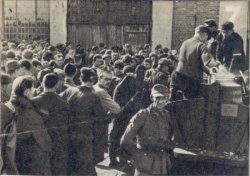
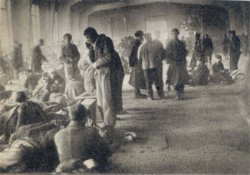
Warsaw Uprising insurgents in hall # 7 in Pruszkow
In Pruszkow they slept on a cement floor of Hall 7 - heavily guarded and fenced off from the rest of the camp. From there, they were taken in locked cargo trains to Stalag XIA in Altengrabow near Magdeburg.
Since a possibility of carrying on fighting was exhausted, food scarce and prospects of receiving help non existent, Chief Commander - general "Bor" decided to capitulate. The surrender negotiations started by the end of September. On September 30th, delegates of the Command Centre of the Home Army - colonel Karol Ziemski (codename Wachnowski) and lieutenant "Scibor" crossed the front line at the intersection of Zelazna Street and Aleje Jerozolimskie and were driven by the Germans to the general von dem Bach headquarters located in Ozarow, in a heritage mansion belonging to the Reicher family. This was the begining of negotiations to stop the combat.
The Polish negotiators conducted talks regarding the evacuation of civilians from Srodmiescie. Ceasefire on October 1st and 2nd between 5 a.m. and 7 p.m. was agreed upon. The Germans designated 5 locations on the west sides of Aleje Jerozolimskie, Grzybowska, Panska, Piusa, and Sniadeckich Street as a check points for the civilians leaving the city.
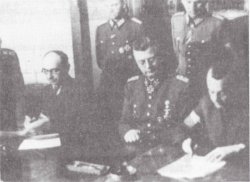
Signing of the capitulation agreement in Ozarow near Warsaw.
From left: Colonel Kazimierz Iranek- Osmecki, codename "Jarecki", General Von Dem Bach and Colonel Zygmunt Dobrowolski, codename "Zyndram".
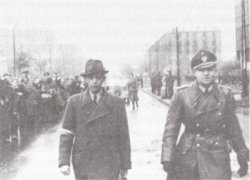
Gen. Tadeusz Bor- Komorowski on his way to German captivity
At the front of the South formation marched the the members of the Command Centre of the Home Army, and at the front of the North formation - the Command of the Warsaw Region. All soldiers had white and red armbands. Officers, young boys and girls were grouped in the fighting order. They were armed with weapons taken from the enemy or produced in insurgents machine shops. After parading in front of their highest rank commanders, formations entered the German positions and then came the most difficult moment for soldiers- surrender of the arms. Weapons laid down were, in most cases, intentionally damaged to prevent their reuse by the Germans.
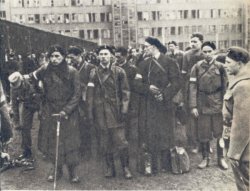
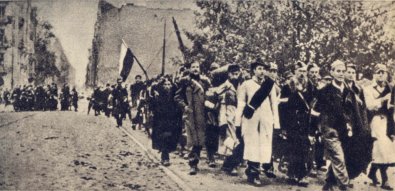
Insurgents on the way to Ozarow
Surrounded by the guards, insurgents marched West. At dusk, tired POWs from Srodmiescie South reached Ozarow, the column from Srodmiescie North arrived later. The same day, general Tadeusz Bor-Komorowski and officers from the Command Centre were brought under escort to the railway station in Ozarow. From there they travelled in a special train to Kruglanken near Gizycko. First, gen. Bor stayed in Kruglanken, later, he was transferred with other officers to Oflag 73 Nurnberg Langwasser near Nurnberg, and next to Colditz, Koenigstein and Laufen. There were 5 other generals from the Uprising with him:
Antoni Chrusciel - codename "Monter" - Commander of the Warsaw Corps of the Home Army
Tadeusz Pelczynski - codename "Grzegorz" - Deputy Commander of the Home Army
Albin Skroczynski - codename "Laszcz" - Commander of the Warsaw Disctrict of the Home Army
Kazimierz Sawicki - codenames "Opor", "Prut" - Command Centre of the Home Army
Janusz Bokszczanin - codename "Sek" - Command Centre of the Home Army
Tadeusz Kossakowski - codename "Krystynek" - Command Centre of the Home Army
On April 14 1945, the gestapo arrived in Laufen and demanded the release of Poles. The fall of the Hitler's Germany was near and the camp commander, afraid of his responsibility, refused the demand. The Britons and Americans interned in the camp bribed the German soldier to pass the information to the Suiss delegate staying nearby - Feldscherer. The Suiss had intervened with the German general, who was a commander of POW's camps in South of the Germany and received from him assurances that Poles will not be relocated from Laufen.
Contrary to these assurances, 12 hours later, the Poles were taken to the Stalag XVIII 317 C in Markt Pongau in Austria. Upon being notified about this, Feldscherer intervened once again, this time with the Chief of POW Deparment SS-Obergruppenfuehrer Gotlob Berger and managed to convinced him that in his own best interest he should transferred the POWs under the care of neutral Switzerland.
As a result of the Suiss efforts, Bor- Komorowski and other generals accompanied by the Suiss diplomatic attache drove towards the Switzerland border in a Red Cross car. On their way, they were stopped by the guard of 103 division of USA army and directed to the division's command Centre in Innsbruck.
Americans took them in jeeps to already liberated Oflag VII A in Murnau, which housed the majority of Polish generals taken POW in 1939.
In accordance with the provisions of the Capitulation Treaty, a designated Assistance Batallion remained in Warsaw to ensure the order. The batallion comprised of the three armed companies of the Home Army counting about 300 soldiers from Batallion "Kilinski" and about 120 soldiers from the Batallion "Milosz". On October 9th, 1944 at 7 a.m., the Assistance Batallion of the Home Army left the quarters at Chmielna St. and marched to the Ozarow detention Camp.
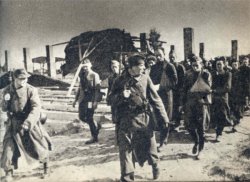
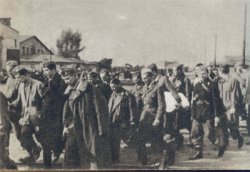
On the way to a transition camp
Some of the Home Army soldiers didn't surrender and left the city in a disguise, blending in with the civilians leaving for Pruszkow. Between them were the soldiers of Kedyw, who soon started to conspire. A certain number of insurgents managed to reach forested areas around Warsaw or cross the river. Amongst them were the soldiers of the People's Army who were not granted combatant's rights and had no other options. Some of them were given the Home Army membership cards to protect their lives. Between those taken prisoners were also soldiers of Jewish origins, in hiding organized with help of their fellow soldiers.
On October 6th, 1944, the first train with the POWs from the Uprising left Ozarow and after two days reached the Stalag 344 Lamsdorf (Lambinowice) located in the region of Silesia Opole - the oldest and the biggest POW camp in the III Reich. On October 6th and 7th, there were 5789 POWs who arrived at the camp - between them officers and privates and a group of 600 underage soldiers, boys between 12-18 years old. They remained in this camp until October 18, 1944, when they were directed to other POW camps such as: Woldenberg, GrosspBorn, Murnau, Muhleberg, Sandbostel and Sonderbarakenlager Oflag XI B/Z in Bergen.
On October 7th 1944, the 36 regiment of insurgents left Ozarow and two days later reached the Stalag XI B Fallingbostel. This was a camp for the Polish POWs taken prisoner during the campaign of 1939.
Overall, from all districts of Warsaw over 15 000 soldiers of the Warsaw Uprising ( between them 6 generals) were taken prisoner by the Germans. 11 668 of them went to the camp in Ozarow, others to the camps in Skierniewice and Pruszkow.
The Wehrmacht prepared the transport lists very diligently. Apart from personal data such as: the first and last name, place and date of birth, father's first name and mother's maiden name, the lists contained also the millitary rank, place and date of being taken POW, next of kin address and remarks about health condition. Based on these data, POWs were directed to such camps as: Stalag 344 Lamsdorf, Stalag X B Sandbostel, Stalag XI A Altengrabow, Stalag XI C Fallingbostel, Stalag XI C Bad Sulza, Stalag VII C Sagen (Zagan), Stalag XI D Nurnmberg, Stalag IV B Muelhlberg.
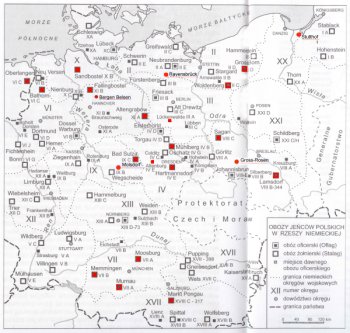
Map of the German camps housing the Warsaw Uprising POWs
The stay in Ozarow was short: from 4th to 15th of October, 1944. The living conditions were scandalous. The camp was heavily guarded by the Germans, but despite that, the residents of Ozarow, disregarding the German regulations rushed to help with medical aid and food supplies. The action was organized by the Estate Council, Central Council of Care and the Polish Red Cross - organizations that employed the service clerks of the Home Army: logistics, Citizens Corps and sanitary services under doctor Antoni Orsik "Boncza".
The transport of POWs from Ozarow to the permanent camps was scandalous as well - they travelled in cattle's wagons. Many of them died or perished on a way to a camp or during their stay in camps.
The organizing of POW camps in Germany was completed before the start of the WWII. During the war, the German POW camps (Oflags for officers, Stalags for lower ranks) were marked by the number of the military region of their location. The issues pertaining to the treatment of POWs and sick or wounded in active armies were governed by the Geneva Convention of 27 July, 1929 and a supplementary convention called Red Cross Convention. POWs after detaining shall be registered and directed to the camp located away from the front lines. POWs shall be treated with respect and assigned the work suitable to their health, accommodated decently and receiving the same meals as soldiers of the captor's army.
The country detaining POWs was under the obligation to inform the International Red Cross about the numbers of detainees and their place of stay. A mandatory work in POW camps concerned only lower military ranks (non-commissioned officers and privates) but any particular assignement was contingent on the medical condition. The work was to be performed only by the healthy POWs and supervision was to be entrusted to non-commissioned officers. The work should had been remunerated and POWs were entitled to one day off weekly. The Geneva Convention prohibited the employment of POWs in places of military designation. Despite that, POWs were working on military ranges, in ammunition factories and on airports construction. They were forced to work also on farms or as undertakers. The Germans purposely aimed to exhaust them physically, that's why they were forced to work and often had their food rations stolen. In those circumstances the only way to maintain good health was through the food aid received from the family and charitable organizations. Grueling work, combined with unsafe condition, poor nutrition and a bad treatment, resulted in many accidents and illnesses.
The biggest group of insurgents (5,789) went to the transition Stalag VII B-344 Lamsdorf (Lambinowice). Among them were 600 underage soldiers of the Warsaw Uprising - 12-18 years old boys. The first group arrived in Lamsdorf on October 6th, 1944. These were soldiers from 15th and 21st infantry regiment of the Home Army. They were transported in an inhumane conditions, 80 person per a cattle wagon. From the railway station they half marched, half-run the 6 km distance to the camp. Upon entering the camp they were not permitted to draw water from any of the two wells located in the camp. It was not until the colonel Franciszek Rataj - codename "Pawel", the commander of the 15th infantry regiment intervened with the German genera,l that POWs had received the water and later the bread. The newly arrived were left overnight on an open skies assembly square. The next day, after all of them were searched and robbed from any valuable personal items, they could enter the barracks. Once there,they were required to remove the white-red armbands which they categorically refused to do. The barracks were dirty, poorly insulated with broken windows, leaking roofs and infested with bed bugs. There was no heating system. The dug holes served as outhouses and lavatory was made out of troughs filled with cold water.
The POWs stayed in this camp until October 18th, 1944. After receiving the POWs numbers they were relocated to different POW camps in Germany and Austria, amongst them to Woldenberg, Gross-Born, Murnau, Muhlberg, Sandbostel and Bergen Belsen. Officers were placed in Oflags among others in Murnau.
The transport of POWs from the 36th infantry regiment of the Home Army left Ozarow on October 7th and after two days arrived in Stalag XI B Fallingbostel near Hannover. Here the POWs were treated better than in Lamsdorf. The camp was stationary and housed also the soldiers from 1939 campaign. It was situated in a boggy location. Polish POWs were working in meliorating the grounds and recovering the peat. On October 22nd the POWs from this camp were relocated to other locations.
Another transport from Ozarow went directly to Stalag XB in Sandbostel and to Stalag XI B Fallingbostel. Insurgent's hospitals and wounded were taken from the West (Zachodni) Station to the hospital-camp in Zeithain (there were 586 women in this transport). In Zeithain IV-B/Z which was a branch of Stalag IV-B Muhlberg near Dresden, there were about 1600 POWs including over 1000 sick and wounded, 40 doctors and several hundred nurses, paramedics and administration personnel.
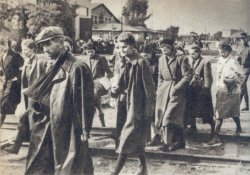
Uprising paramedics on the way into captivity
The second group of wounded was sent from Pruszkow to Stalag XIA in Altengrabow and Gross-Lubars near Magdeburg (there were about 445 women). The camp in Altengrabow took about 2599 wounded and sick. Severely wounded were taken to the hospital A, others to the hospital in a branch camp in Gross Lubars, remaining were housed in barracks and tents situated on a barbwire fenced sport game yard. Polish POWs doctors tried to provide medical help to their fellow soldiers. This was very difficult. There was a shortage of basic medications, surgical instruments and sanitary supplies. Because of this, several tenths of wounded POWs died before the end of October 1944.
All together there were about 4900 wounded evacuated from the Uprising hospitals: 500 from Mokotow, 400 from Zoliborz and 4000 from Srodmiescie.The majority was taken to POW hospitals in Germany. Some were left in different locations of Warsaw suburbs and also in Skierniewice and Lodz. First transports of wounded from Warsaw started on October 7th, 1944.
The first aid from the Red Cross in Geneva hadn't arrived in Mulhlberg until the end of November. POWs were housed in 20 wooden barracks, abandoned few days earlier by the Italians. The barracks were primitivelly furnished and infested with bed bugs. The Polish part of the camp was separated from the rest with a double barbwire fence. The place was surrounded by the guard's towers and lighted at night with a mobile flood lights. There was no sewer, human waste was taken outside in buckets.
Water came from a hydrant - one for every four barracks. The whole camp had one swimming hole that POW could use once weekly under the guard escort.
Despite the primitive conditions, the Polish commander of the camp, colonel MD Leon Strehl organized in Zeithain IV-B/Z a well functioning hospital that had even the obstetrics department. Amazing surgical result accomplished by the chief surgeon colonel MD Tadeuesz Betkowski were subject of German surgeons admiration - they were coming from Dresden to observe. There was also an active group of internal medicine doctors.
The POWs in Zeithain had started organizing live performances and other activities. There were groups teaching foreign languages, professional development courses and lectures. Once weekly the medical staff had a meeting to discuss the more complex cases and share the knowledge of experienced surgeons with younger colleagues.
In the spring of 1945, with the front line approaching, a possibility of evacuation of the camp further west to Brema became very real. On the night of April 21/22 the German commander of the camp - Oberstarzt Lucke summoned the colonel Strehl and let him know that he had received the order to leave the camp along with the personnel. He could have taken along the volunteering POWs, but only these who were able to withstand the gruesome march over a long distance without an assurance of food, accommodation or transportation. After the meeting of doctors, officers and the representatives from barracks, POWs decided to stay put.
The German commander passed to the colonel Strehl the keys to the food store-rooms and some weapons as well. The same night the Germans left the camp. Polish POWs manned the guard towers and exits and placed guards at the food storerooms where, according to the German information, was enough supplies to last for three months. On April 23rd, the first Soviet formations appeared near the camp only to retreat after few hours in the direction of East.Soon,they were followed by a long columns of the French, Italian and Russian POWs, as well as some Poles. The rest remained at the camp waiting for the situation to normalize. After liberation, the camps operated for a while as a transitional place for arriving from different places POWs, prisoners from concentration camps and civilians returning from a forced labour locations. This continued until July 1945. Later, the hospital was evacuated to Torun and after few months closed.
POWs, after arriving in different camps, were often directed to the forced labour formations called Arbeitskommando. Usually these units operated in quarries, on farms, highways and airports construction and in military industries. In the last two cases it was a clear violation of the Geneva Convention stated clearly in one of the provisions, that POWs shall not be working in military industries.
The good side of this work was that it broke the boredom and hopelesness of the camp existence. Not always was it an easy work, especially in quarries. Poor food didn't not compensate for the heavy physical effort. Relatively, the best work was on farms, not as labour intensive and with a much better food.
The POWs treatment by the guards had changed for the better. Facing the end of the war, the Germans acts of cruelty and violence against the POWs were less frequent. First signs of the chaos and breaking down of the III Reich encouraged many attempts to escape from the camps. POWs tried to get to the Polish Military Forces in the West, knowing by the grapevine the actual situation in Poland, where soldiers of the Home Army were facing prosecutions and relocation by the Soviets. In most cases attempts to escape did not succeeded and fugitives were brought back to the camp and incarcerated in a solitary confinement or working in a penal work formations.
The Uprising officers were relocated from the transitional camps to Oflag IIC Woldenberg in Pomorze and Oflag VII A Murnau near Munich.
The camp in Woldenberg designated for Polish officers and their batmans was located near Dobiegniew and situated on about 25 ha of land. The construction of the camp started at the end of 1939 and was completed in a second half of 1941. About 500 Polish soldiers worked at the construction site - despite the severe winter condition they were housed in wooden barracks and tents. Eventually, 25 brick and mortar barracks were constructed to house the detainees and 6 additional buildings to be used as lecture halls, workshops, offices of the Polish administration of the camp etc. In addition, there were 2 kitchens and auxiliary buildings used as canteens, auditorium, cafe, and herbarium. On the outskirts of the camps there were quarters for sick, mechanical shops, baths and jail. The command centre of the camp was separated from the main camp. The whole camp area was fenced with 2 m apart double barbwire 2.5 m heigh. The camp was surrounded by 8 guard's towers equipped with light and heavy machine guns, mobile flood lights and phones. Parts of the camp itself were also separated by the barbwire fence. In an organizational structure - the Oflag II C Woldenberg comprised two subcamps: East and West, each containing 3 batallions (about 10000 men each), and each of them respectively - companies (2 to each barrack).
In Woldenberg, at its height there were 6740 detainees; 5944 of them officers and 796 lower ranks. After the fall of the Warsaw Uprising in 1944 some of the Home Army insurgents - officers arrived in this camp as well.
In the face of the approaching frontline the Germans had started an evacuation of the camp. On January 25, 1945 all detainees from the subcamp West were evacuated and later those from the subcamp East. The latter group was intercepted during relocation and liberated by the Soviet army on January 30th in Dziedzice near Barlinek.
Oflag II C Woldenberg was a flagcamp - a model camp where blatant violations of the Geneva Conventions did not occur.
The camp site in Murnau had dimensions of 200m x 200m and consisted of few barracks, an assembly square, a guardroom and patrol posts. The camp was barbwire fenced with a guard towers in each corner. Detainees were housed in a few barracks blocks. The officers were placed in specific blocks according to their ranks. About 1000 Polish officers stayed there since the campaign of 1939.
After capitulation of the Warsaw Uprising in 1944, there were about 5000 officers in Murnau, majority of them Poles. Between them were brothers Markowscy from "Baszta" - including Jan with his accordion and a treasury of songs. Quite quickly everybody in the camp was humming " Margaret - the Nurse" and " The Mokotow's March".
After the end of the Uprising, among the group of officers who arrived in the camp was major Latyszonok - the Soviet officer under the command of general Berling, the commander of the only formations of the People's Army which managed to cross the Vistula River in an attempt to help the insurgents in Warsaw. Major Latyszonok had fought with the group "Radoslaw" in Czerniakow during the last two weeks of September 1944. Initially he and his soldiers were sent to the camp in Sandbostel.
Also in Murnau was a cavalry commander Witold Pilecki, codenames: "Witold Druh", "Tomasz Serafinski", who at the end of 1940 purposely got himself arrested to be sent to the concentration camp "Auschwitz" and gather intelligence. In April 1943 Witold Pilecki escaped from Auschwitz and reported to the command centre of the Home Army. During the Warsaw Uprising he had fought with the "Chrobry" formation in Srodmiescie.
When Murnau was liberated Witold Pilecki joined the 2 Corps in Italy. In October 1945 he returned to Poland and organized the intelligence gathering group collecting information about political situation and the fate of the Home Army soldiers. Arrested by the Security Service (UB), tortured and charged with spying for the London based government had been condemned to death and murdered (shot in the back of the head) in a Mokotow prison on Rakowiecka Street.
On March 22nd an additional group of 381 officers arrived in Murnau. They came from the evacuated Oflag II C Woldenberg. Shortly before the end of the war Nazis were plannig a "liquidation" of Polish detainees. The German Commander of the Murnau camp - colonel Oster advised general Rommel (the Polish commander of the camp) that the Gestapo centre in Munich had been lobbying Berlin to get the camp under its purview in order to "cleanse it from an extremely hostile atmosphere between detainees". The real threat of a mass murder of Polish POWs had lasted until the liberation of the camp by the Americans.
On April 29, 1945, during the oflag assembly a plane with Polish insygnia had appeared in the sky, circled above the assembly square, tried to signal something and went away. Soon on the road to the camp appeared American tanks. At the same time from the other side of Murnau 2 German cars approached. They stopped upon noticing the tanks. Germans had been taken by surprise. SS officer in the first car opened fire from the machine gun, at the same time his companion jumped out of the veihicle. Both men were killed on a spot by Americans. The same fate met the passangers of the second car. Among the killed Germans was SS general Fik. His briefcase contained the letter signed by Himmler. It was an order to kill all 5000 Polish officers in Murnau. To
execute this task Fik had had at his dsposal an SS group in 40 armoured vehicles that started from Munich. Most likely the SS-man intended to assemble the POWs and killed them with the machine guns fire from guard's towers.
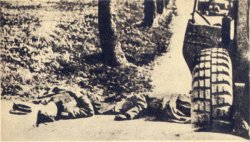
SS commander and his lieutenant killed by Americans
After finishing off the Germans, one of the Americans' tank smashed the entrance gate and entered the assembly square. The representative of POWs welcomed American soldiers. He had addressed them in English. The commander of the tank shook his head and answered in Polish: " My name is Szewczyk, we came to liberate you". He was from Kalisz.
The map of POWs camps in the III Reich shows that during a few months since the capitulation of Warsaw till the capitulation of the Germany, POWs were constantly transferred from one camp to another. The reasons for this probably stemmed from the fact of the overcrowding in camps even before the arrival of insurgents as well as an approaching front lines requiring relocation of the camps deeper into German territory. A majority of POWs was evacuated to Sandbostel X B near Hamburg. By the end of WWII the Germans had in this camp about 15000 POWs of Polish origin and few thousans of POWs of different nationalities.
During the first day of April 1945, the commander of Sandobostel camp had released into Gestapo's custody the colonel Karol Ziemski, codename "Wachnowski", colonel Mieczyslaw Niedzielski, codename "Zywiciel" and 27 other officers of the Warsaw Uprising - most of them members of Kedyw. They were accused of forming a secret organization and conspire to overtake the camp by force. Upon the arrest they were taken to the concentration camp in Neuegamme. There was a serious concern that they could be murdered. The Norvegian and Danes POWs informed about this danger a Red Cross mission, which at the time had been conducting camps inspections with a count Folke Bernadotte - a nephew of the Swedish king. Bernadotte intervened with Himmler. The good relations with the Swede were crucial for Himmler since he was planning to use him as a mediator in ceasefire negotiations with the Allies. Himmler consented to the release of Polish officers. They received back their uniforms and were taken to Koln to an "educational camp" (Arbeitserzie-hungslager) in Hesse-Russe. From this camp they were sent to Stalag II E in Schwerin and later to Oflag X C in Lubeka. They were liberated on May 2nd by the British.
By the end of April 1945, a majority of Sandobostel POWs were evacuated by foot to Bad Schwarz near Lebeka, where they were liberated on May 1st by the British forces. Polish POWs, who remained in Sandbostel were liberated on April 29th,1945 by the Canadian forces.
With the tightening of the allied loop around the Germany, many more POW camps were liberated. Depending on the location, they were liberated by the Russians, Americans and the British. Some POWs liberated by the Red Army had tried to go West and join the Polish Armed Forces there. This in particular applied to soldiers from the regions annexed by the Soviet Union. Many Warsowians upon learning about the persecutions faced by the Home Army soldiers from NKWD and communist regime did not returned to Poland.
Insurgents who had chosen to immigrate settled mostly in Britain, Canada and the United States. Many stayed there until the end of their lives. Often, life didn't treat them well. Many respected, often high rank officers, aged and unaccustomed to a new reality gad been forced to work as janitors, attendants and waiters. Some, after many years of immigration, returned to Poland. Most of the younger insurgents had decided to came back to their country. Their lives took different turns. Some were arrested, charged and condemned to many years in prison and sometimes faced a death penalty. It was in 1956 when the policies towards the soldiers of the Home Army ("spat-on dwarfs of reactionism") had changed.
prepared by Maciej Janaszek-Seydlitz
translated by Ewa Bultrowicz
Copyright © 2007 Maciej Janaszek-Seydlitz. All rights reserved.